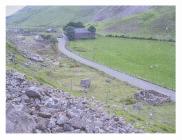The Chapel and the Boulder
Items in this story:
The end of the world?
The residents of the small hamlet of Drws-y-coed must have thought that the end of the world was upon them on the afternoon of Wednesday, 17 February 1892, when a huge boulder fell from the side of the mountain and crashed through the roof of the chapel below.
Drws-y-coed chapel was first opened in 1836 and stood at the foot of Clogwyn y Barcud, the mountain-side beneath which the workers mined for copper. Deep within the mountain the workers would blast the rock at each of the three shifts during the day to extract the ore and this would send tremors through the valley several times a day. It is said that sometimes the force of the tremors would set the china rattling on the dressers of nearby homes.
It seems miraculous therefore that no more boulders were sent tumbling from the side of the mountain.
A lucky escape
The rock that fell on that February afternoon went straight through the chapel roof leaving a huge hole which could not be repaired. In the chapel house next door a local man, William Morris, was laid at rest and a vigil had been planned for that night. In attendance at the time, caring for the grieving widow were three sisters, Annie Francis, Mary Evans of Drwscoed Farm and Mrs Japheth of Pwllheli who was 90 years old. It was extremely fortunate that the rock hit only the chapel and not the adjoining house.
The damage to the chapel was such that there was no possibility of repair and the local residents set about raising the funds to build a new chapel. They were kindly leased land across the road from the site of the original chapel by the local landowner Assheton-Smith Esq. of the Vaynol Estate, Bangor. It is estimated that the cost of building the new chapel and house was around £550 and that through the effort and hard work of the 56 chapel members, the debt was cleared in no time.
Rebuilding
The new chapel was ready just over a year after the catastrophic event and the first service was held at Easter 1893. The village had been without a chapel for fourteen months and during that time residents took their turn in hosting the Sunday service in their own homes. The work of the community in rebuilding the chapel was great and it is said that one man, more than any other, was an inspiration. Hugh Jones of Talymignedd Isaf would walk around the area with two sticks and if he saw a stone that would be suitable for the building work, he would call on whoever was nearby to help him raise the stone to his back and he would carry it to the chapel.
It was through such effort as this that the chapel was rebuilt and opened in 1893.
The chapel remains in use today though the population of Drws-y-coed is considerably lower than in the hey-day of the copper mines. It is said that when the mines were at their busiest, some 250-300 people would attend chapel on a Sunday but since their closure in 1924 the population of the area has fallen.
Across the road from the new chapel it is possible to see the remains of the old building and the offending boulder is still where it landed that February afternoon.


